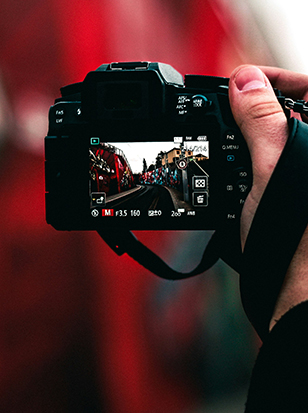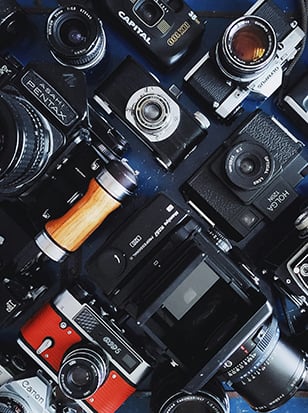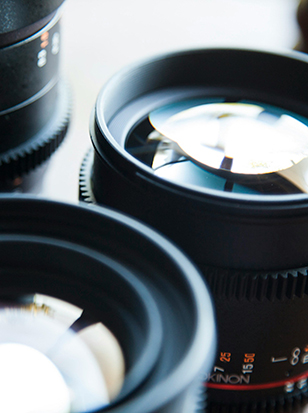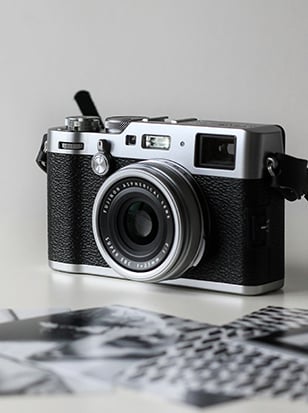
Talking about the best camera accessories can mean talking about all sorts of different things. Everyone’s needs are different, and everyone’s camera/lens setup is slightly different, and an accessory that’s hugely useful for one photographer may not be of any use at all to another.
So, this isn’t meant to be a catch-all list of things you unequivocally need in order to be a good photographer. Rather, we’ve put together a generalist’s guide to the accessories our team of experts have found most useful over the years, in order to give you an overview.
In many cases, we have dedicated guides to specific types of camera accessory, and we’ve linked out to these where relevant — and in each case, we’ve tried to give an overview of the main uses of each type of accessory, to give you an idea of whether it’ll be useful for you or not. So, let’s get into the best camera accessories to buy in 2024.
Quick Navigation
Camera Bag
The dangers a camera faces are seemingly endless; during winter months damp, cold and condensation can all pose a significant health risk, while in the summer dust, pollen and heat can be equally damaging. And that’s before you take into account the risks involved in actually using the camera out and about, where it can be dropped, banged into, scratched, knocked and generally abused.
A decent camera bag not only offers vital protection from everyday knocks and bumps, but also provides a far more convenient method of transporting your camera gear than simply stuffing it into your pockets.
There are a huge variety of bags available, from those which house just your camera and a lens for protection with minimum bulk, to those which will take your camera, all your lenses, a tripod, a change of clothes, your lunch and the kitchen sink.
There are shoulder bags, backpacks, waist belts, hard cases and many more variations. The exact type and model will of course depend on what you intend to use it for and how much equipment you need.
For instance, a rolling case with extending handle is ideal for transporting multiple cameras and a collection of lenses and accessories through airport terminals, but is less suited to carrying a single camera and lens combination across mountain passes.
See more: Best camera bag for photographers, Best camera bag for filmmakers
Tripod
Many photographers manage quite nicely without a tripod and if your photography is mainly of fast-moving subjects that require a fast shutter-speed anyway, then a tripod may not be essential. That said, plenty of wildlife and sports photographers use them to help keep their huge lenses steady, and if landscape photography is your thing, then a decent tripod can be as important as the camera and lens that sit on it.
Tripods come in all sorts of shapes and sizes, and it’s possible to pick up a lightweight tripod complete with a head relatively cheaply. However, a tripod's one and only function is to keep your camera absolutely still to avoid blurred images and as simple as this task may seem, some tripods do it better than others.
A tripod is essentially just three legs with a platform – it’s the tripod head that allows you to point your camera in different directions and position your shot exactly as you want it. The advantage of buying the tripod legs and heads separately is that, while all tripod legs essentially do the same job, the heads can be very different depending on their designated use, so being able to choose the exact ball, pan, or 3-way head that you need allows you to get the perfect, tailored set-up for your photography.
See more: Best travel tripod for photographers
Filters
In today’s age of digital manipulation, it may seem that many creative filters have become redundant. However, there are still some effects which are better applied with filters at the time of shooting rather than in Photoshop.
Circular polarising filters enhance colours and reduce glare and reflections and are perhaps the most difficult to recreate using software so are an excellent addition to your kit bag. Landscape photographers tend to be strong advocates of the circular polarising filter, as it can add punch to skies and eliminate unwanted reflections from water and shiny surfaces. When mounted on the lens they can be freely rotated to change and control the effect of the polarising.
Another favourite of the landscape photographer is the graduated neutral density (GND or graduated ND) filter. These filters gradually darken across the image, going from tinted at one side to clear at the other. The strength of the tint and how the graduation appears varies depending on the filter, but these graduated ND filters are regularly used by photographers to help balance a bright sky against a duller foreground and can be used in conjunction with a polarising filter for maximum effect.
Because of the need to position the graduation in exactly the right place for the image, the best way to use a graduated ND filter is in the form of a square or rectangular filter such as the Lee or Cokin systems. These allow you to slide the filter up and down in a holder to position it correctly.
As well as the graduated variety, a straightforward neutral density (ND) filter can also be useful. These are also available in a range of strengths and act much like sunglasses for your lens, reducing the brightness of an image without affecting the colour (hence “neutral”). There may be occasions where you want to use a wide aperture to minimise depth of field but where the bright lighting means that even at the fastest shutter-speed and the lowest ISO there’s too much light coming into the lens – for example, portrait shots outside on a sunny day. A neutral density filter will reduce the light, enabling wider apertures.
Another frequently seen use for an ND filter is to permit the use of longer shutter speeds, again by reducing the light entering the lens. This means shutter speeds of seconds rather than a fraction of a second can be used to get motion blur effects. Although this has a variety of creative applications, by far and away the most common is blurring the movement of water in waterfalls or waves to create a milky texture to the water, something that requires long exposure times which are easily facilitated with a dark neutral density filter.
Read more: Best camera lens filters
Batteries
Yes, your camera will come with a battery, and yes, it will be rechargeable. As such you may feel that purchasing an additional battery is unnecessary. However, before you overlook a spare battery in favour of a slightly more exciting way to spend your money, just think about the benefits it ll will offer.
Firstly you would have to be an extremely disciplined photographer to remember to put your battery on charge after every time that you’ve used your camera. It only requires you to forget to do it once, and resulting in you coming to use your camera only to find you have little or no power. Having a fully charged backup on standby could save your day’s photography.
It’s also quite possible for a photographer to run out of power during an intensive day’s shooting. If you’re out and about when this happens and you don’t have a spare, you’ll have to stop taking pictures. Bear in mind that even though most modern digital batteries will last for some time, factors like cold weather, prolonged use of the LCD screen or regular firing of a built-in flash will drain the battery faster. In very cold weather a battery can stop working even if it still has power. Keeping a spare battery on your person means you can swap over and warm the dead battery back to life while using the spare.
Finally, while it’s unusual, it’s not unheard of for a battery to fail. All batteries have a finite life and if you are only using the one battery, recharging and discharging it over and over again, it will eventually fail. Murphy's law dictates that any failure will take place at the most inopportune moment, thus maximising the disaster/embarrassment/frustration factor. As such, a spare battery is excellent insurance.
Lens Hood
Question: why do you need a lens hood? If your answer is “to shade the lens from incidental light that can cause flare and distortions in a photograph” then you are right.
Well, partly right. Although shading the lens is a lens hood’s primary function (they are sometimes known as lens shades) they also offer a significant amount of protection for the front element of your lens from more physical threats. A lens hood will shade your lens from dust and moisture in the air and, perhaps most importantly, will act as a bumper for your lens against impact.
If you carry your camera around your neck as you move about or navigate around an obstacle (a stile, gate, doorway, person, etc.) you can suddenly find your camera being swung into said obstacle at an unhealthy velocity, and more often than not it will be the front of the lens that absorbs the impact.
A lens hood will not only act as a physical barrier to prevent the glass from coming into contact with the obstacle, but if anything is going to break as a result of the lens/object interaction, it will be the lens hood rather than a more important component.
Cleaning Kit
Fact: if you use your camera, it will get dirty. The more you use it, the dirtier it is likely to get. Even if you don’t take your camera up mountains, across fields or through woods, dust, moisture and greasy marks from your hands and face can build up on your camera’s lens, LCD screen and eyepiece. As such, a basic cleaning kit consisting of a soft brush, a lint free cloth and an air blower is a sensible and relatively cheap purchase for any new camera owner.
Sensor Cleaning
You may also be aware that your camera’s sensor can pick up dust and marks over time. While there are cleaning kits designed specifically for this, not everybody is comfortable with cleaning their own sensor and would prefer to get it done by a professional. In addition, some manufacturers do not recommend that you clean the sensor yourself.
However, cleaning the external surfaces of your camera and lens is not only easy, but is something that every camera owner should regularly do. A smear on the front element of your lens can spoil an otherwise excellent photograph, and passing your camera to someone to show off a great shot on your camera’s LCD screen is embarrassing when the first thing they do is wipe a greasy nose smear off the glass!
Lens cloths do a great job, but lens pens offer even more cleaning power, featuring both a super-soft brush and a velvety pad for removing greasy smudges such as fingerprints.
One of the cheapest and best accessories you can get hold of for general cleaning is a rocket blower. These cool little accessories blow filtered air out of a small nozzle, giving enough pressure to remove dust, sand and other residue from lenses and cameras.
Battery Grip
A battery grip attaches to the bottom of your camera to provide extra battery capacity and additional controls. They tend to only be available for professional and high-end enthusiast cameras, but if one is available for yours, it is a sensible addition to your photography kit that offers several advantages.
Most grips allow you to use two of the camera’s standard batteries simultaneously for longer use without having to stop and change battery packs. Many are also supplied with an insert that allows normal AA batteries to be used in place of the camera specific lithium-ion packs. This is a real advantage when shooting out and about — should your battery fail and you’re not carrying a spare, a near-ubiquitous AA battery is far more easily acquired than the model-specific battery supplied with your camera.
Battery grips are also sometimes known as “vertical control grips” because of the additional controls they provide. More specifically, most feature a shutter button, a control dial and other buttons that make these functions easier to access and operate when the camera is being used in the vertical or “portrait” position.
Remote Control
Camera shake is one of those unfortunate camera effects that can spoil an otherwise perfect picture. Worse still, you don’t always notice it fully until a picture is displayed at a larger size on the computer screen.
A remote release is the perfect solution for ensuring your fumbling hands don’t interfere with longer exposures. Whilst a camera’s self-timer can also be used, a release allows more exact control over the moment the shutter is triggered – perfect for fast-paced action, including fireworks.
Memory Card Storage
If there is anything more important than your cameras and lenses, it has to be your data! Our images are our lives as photographers, and looking after them from shoot to studio is vital. An easy way to make sure none of those SD, CF, XQD or Micro SDs go missing is get a card wallet.
These come in a range of sizes, protecting anywhere from four to twenty storage cards. Some provide waterproof and crushproof construction for another level of security for your precious images. Given that they cost about a fiver, it’s not worth going without and risking losing cards in pockets and other small compartments!
Extra Accessories
Finally, there are quite a few unconventional accessories that you may not have ever thought about before. A lot of these aren’t photography or video products per se — but over the years, our team has found all sorts of unexpected ways these things can be put to use.
Head torch
Don’t get caught out as the light fades away at the end of the day! A head torch will leave your hands free to operate your camera and allow you to focus a bright beam of light exactly where it’s needed.
These are also great for light painting techniques, as their output can be changed, allowing you to tailor the effect they have when their light strikes a subject.
Heat pads / hand warmers
Aside from rain, there’s nothing worse than the cold for knocking morale when taking pictures on location. Whether you’re catching first light on a chilly summer’s morning before sunrise or hanging around for star trail exposures to complete in the middle of the night, keeping warm and comfortable should be a priority.
Hand warmer pads are a great way to keep your spirits up, and they last ages (seven hours, single use). They can be stored in your camera bag for ages, too – they only begin working when exposed when the packet is opened and they’re exposed to the air.
Grey card
When it comes to getting the colours right in your shots, one of the quickest and best ways to do this is to use a grey card at the time of capture.
Grey cards are inexpensive, light and compact, and if you shoot portraits regularly you should really consider getting one. When you’re ready to take pictures, simply get your subject to hold the card for an initial reference shot.
Batch-processing multiple pictures taken in the same lighting conditions also becomes easier as a result of using a grey card – and less time in front of the computer means more time out taking great pictures!
Carabiner
Borrowed from the rock climbing world, carabiners are great for attaching items to the outside of your camera bag. They’re available in all manner of colours, sizes and variations.
These little gems are also great for helping to steady your camera – simply attach one to your camera bag handle and hook it around the central hub or centre column of your tripod. The weight will essentially pull the tripod towards the ground, making it a more solid structure – perfect in windy conditions.
Fifty pence coin
You might be wondering what this has to do with photography. Well, have you ever found yourself unable to attach a camera to your tripod’s quick release plate because you don’t have a penknife, screwdriver or something similar on hand?
If so, you’ll find that an old fifty pence coin is often the perfect tool – it offers a near exact fit and is big enough to get a good grip, especially in cold conditions.
Gaffer tape
Every photographer should have a reel of this stuff in his or her bag. It is simply perfect for so many jobs. If you’ve ever needed to hold a reflector in place, stop a wired remote flapping in the wind, or stick down your studio light cables, gaffer tape is what you need.
Don’t confuse gaffer tape with duct tape. The former is a very strong adhesive, but is nowhere near as good due to its habit of leaving a large amount of residue when peeled it back off again. Gaffer tape, on the other hand, holds strong and when removed leaves very little trace, making it perfect for photographers who don’t want a load of messy sticky gear.
One of my favourite uses for it is holding my zoom and focus rings in place when setting up remote cameras, allowing me to make sure nothing moves and critical focus is maintained without sticking up my lens!
With so many uses, you will never want to leave home without it!
Cable ties
Similar to the above, cable ties are such a handy addition to your photography bag. Ultra strong, they are useful for many things other than just keeping your cables tidy. Out in the field they can be joined together to make an ultra-strong binding for keeping pretty much anything anywhere.
They’re very handy for positioning flashguns in awkward places where light stands don’t reach, or an impromptu rigging of a perch for your garden bird photography.
It’s a good idea to buy the reusable versions, as not only does it mean you don’t have to keep buying new ones after a single use, but they also reduce the plastic waste and are more environmentally friendly.
Shower caps
Sometimes it rains. Actually, a lot of the time it rains here in the UK, and being prepared as a photographer is essential.
If you don’t already have a rain cover you don’t need to spend a fortune to protect your camera from rain, dust and sand. Just grab a shower cap.
Those clear plastic elasticated hotel shower caps are simply excellent for covering up cameras and keeping the rain off at a moment’s notice. Being see-through, they also allow you to view your controls and the LCD when in use. Cheap, handy and perfect for the camera bag.
Folding step/stool
If you are spending a long time on location, think about picking up a folding step or stool.
First off, of course, it’s great to have a compact seat for those long waits for perfect light, conditions or events to unfold. Secondly they’re great for events when you want an elevated view. Strong and compact, they can be used to gain some height and shoot above crowds, or for gaining a new perspective on a tried and tested subject.
Additionally, if you work with hard cases, combine them with a folding step to provide a great way of adding some height for a mobile desk/workstation so you can use your laptop off the ground and save all that bending down.
Notebook and pen/pencil
We photographers have a lot on our minds. So write it down! Having a notebook and pen handy is great for those moments of inspiration, brief location notes, directions and place names you hear about on your travels. You can record details for your captions and keywords, or jot down phone numbers and emails of people you meet when you’re out and about.

FAQs
What are essential camera accessories for beginners?
For beginners, some essential accessories you should look for are a camera bag to protect and transport your gear, a sturdy tripod for stable shots, extra batteries to ensure you don't run out of power, memory cards with ample storage space, and a lens cleaning kit to maintain the clarity of your lenses.
Why do photographers use filters on their lenses?
Photographers use filters on their lenses to achieve specific effects and protect their equipment. UV filters protect the lens from dust, scratches, and moisture. Polarising filters reduce glare and reflections, enhancing colour saturation and contrast. Neutral density (ND) filters allow for longer exposure times in bright conditions, creating motion blur effects or achieving a shallow depth of field.
What should I consider when buying a tripod?
When buying a tripod, you need to think about stability, weight, height, and ease of use. Stability is crucial for sharp images, especially in long exposures. Lightweight tripods are ideal for travel but ensure they are sturdy enough to support your camera. The height should be adjustable to suit your shooting needs, and the tripod should be easy to set up and adjust. You’ll also want to look for tripods with a good locking mechanism and a flexible head for various angles and positions.







